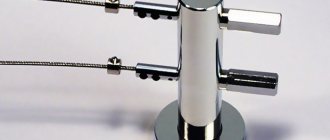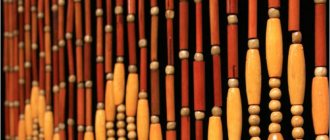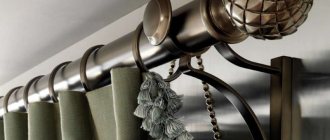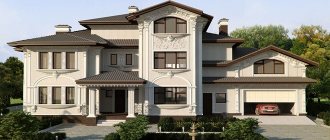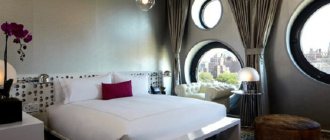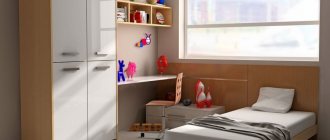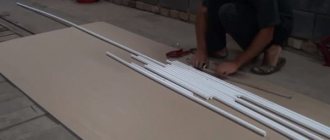Types and classification of wooden cornices
The most popular option for cornices are wooden curtains. They, in turn, differ:
- The type of wood used for production. Models made from hardwood are distinguished by their high strength and noble shade. But products consisting of several rows may be too heavy, so additional, reinforced fixation will be required. The advantage of softwood cornices is the ability to apply carved patterns to their surface. And modern technologies allow you to give the product absolutely any shade.
- Type of fastening. They can be attached to the wall or ceiling. When choosing a ceiling mount, you need to pay attention to the weight of the curtain, especially if the surface is suspended. This option is preferable for an apartment with low ceilings or rooms in which there is no space between the window and the ceiling. The wall method is simpler, but is used mainly in rooms with a high ceiling and a significant distance from the window to the horizontal surface.
- Appearance. Today the trend is complex systems with a large bar on the front side. The fastening mechanism is hidden behind it. Models in the form of a rod, which may have additional sections for tulle and curtains, also remain relevant.
- Number of functional rows. If one curtain is enough, for example, in the kitchen, choose single-row models. Double row is more popular. It is suitable for tulle and curtains. Three-row ones are needed when it is necessary to hang a complex structure with a lambrequin.
Cornices differ in the type of wood, fastenings and appearance.
The wood cornice is a decorative element. To attract attention to it, you need to choose one whose length exceeds the width of the window opening by more than 10-12 cm. And in order for the structure to have a finished look, special decorative overlays are used.
A wooden cornice is a decorative element of the interior.
Wood
The following types of wood can be used to produce a wooden cornice:
- deciduous (oak, beech, cherry, walnut, birch);
- needles (pine, larch, juniper);
- exotic (wenge, ebony, zebran).
Deciduous, coniferous and exotic types of wood can be used for production. The cheapest are pine and spruce. At the same time, they have a fairly attractive appearance and fit well into any interior.
Products made from pine and spruce are considered the most budget-friendly. Oak is recognized as valuable and beautiful. It is difficult to work with, but the product can last a very long time.
Oak cornices are very durable. Cherry is light in weight and easy to process, so models made from this wood are often decorated with patterns.
Products made from cherry are very light. Exotic wood species can highlight the status of a room. But such products are very expensive. And it’s almost impossible to find discounts and promotions on them.
Cornices made of exotic woods emphasize the status of the room.
Form
There are 2 forms of wooden curtain rods: round and rectangular. Round ones are more common. Thanks to their shape, they can make the interior softer, and the movement of fasteners along the bar is smoother and more convenient.
Round cornices make rooms more comfortable. Rectangular ones represent a bar.
Rectangular cornices look like planks. Their design allows you to create a romantic atmosphere in the room by adding additional lighting to the cornice.
Lighting allows you to give the room a special romantic atmosphere.
Dimensions
The length of the curtain rod is selected individually for each room and depends on its area, type and material from which the curtains will be made. For a small apartment, not very wide options in light shades without threads are suitable.
Narrow cornices are suitable for small rooms. When decorating a room in a classic or modern style, choose wide cornices with beautiful carvings.
Wide carved cornices are suitable for decorating a room in a classic style.
Color
Today, when producing products from natural wood, it is possible to paint it in a variety of colors. When choosing the colors of the cornice, you need to build on the colors that are used in the interior.
When choosing a cornice, take into account the colors of the overall interior of the room. Light-colored products are suitable for decorating a room in Provence, minimalism or eco styles. They are hung in rooms with a small area and low ceilings.
Light cornices fit perfectly into Provence, minimalism, and eco styles. Dark products decorated with carvings are used to accentuate classical, modern, baroque and empire styles.
Such carved products are suitable for Art Nouveau, Baroque and Empire styles.
You cannot buy products in a shade that sharply contrasts with the decoration of the room! But it is allowed to choose tones that are very different from the color of the curtains.
Three most popular collections:
- Aluminum is used for the manufacture of profile systems. Unlike other types, such curtain rods can be given any shape, which is very convenient when decorating arches and bay windows. Another advantage of profile systems is their low price position. In addition, they go well with completely different curtains because they remain invisible. Most often, such curtain rods, equipped with electric or remote control, are used in theater and cinema halls. Japanese, Romanesque and Austrian curtains on profile systems give the interior airiness and comfort, without causing any inconvenience during operation.
Accessories and decorative elements
Wooden cornices consist of:
- rods (depending on the model, there may be several, for example, in a double-row – two);
- brackets;
- tips for decoration;
- parts intended for fastening curtains (hooks, clips, rings, eyelets).
Some models may have fleurons - decorative tips attached to a baguette or wooden rod. They can be of any shape (round, pointed, quadrangular).
Some models may have fleurons - decorative tips of various shapes.
Device and functions
The roof eaves are an important element of roofing structures; this term refers to the lower parts of the roof slopes, which are their continuation. Installation of cornices is carried out during the arrangement of the rafter system by increasing the length of the rafters or by installing fillies. On top, the cornice, like the entire area of the slope, is covered with roofing material, and from below it is sewn up using lumber, soffits, and siding. In the roof structure of a house, it performs the following functions:
- Protects the walls of the house from moisture. The eaves overhang of the roof protects the upper part of the external walls from atmospheric moisture and dirt, maintaining their attractive appearance and integrity.
- Prevents the flow of melt and rain water onto the foundation area. The structure of the roof eaves is such that it carries streams of water and blocks of snow sliding off the slope further from the foundation of the house, preventing erosion and destruction of the blind area.
- Gives the roof a finished, neat look. Roof overhangs, being a continuation of the slope, give the structure a more proportional appearance, harmoniously completing the architectural design of the house.
How to make wooden curtains with your own hands
Making a wooden curtain rod with your own hands is not difficult. To do this you need to prepare the following materials:
- 2 slats;
- 2 metal corners;
- self-tapping screws
To make your own cornice, you will need wooden slats. Additionally, you will need a saw, a hacksaw, a screwdriver, wire for attaching hooks, a ruler and varnish for wood processing.
You will need to prepare the necessary tools. The process of making a cornice with your own hands is as follows:
- Length notes are made on the staff.
- The excess is sawed off.
- Corners are attached to the sides. Experts advise attaching two pairs at once, from below and from above.
- Wooden elements are attached to the corners.
- Guides are installed. To secure the wire tightly, its length must be 5 cm greater than the length of the cornice.
- The number of guides depends on personal preference. Self-tapping screws are used to secure the strings.
- At the very end, the cornice is treated with a layer of varnish. It is advisable to repeat the procedure 3 times.
At the end, the finished product must be varnished.
Product length
Selected individually. Depends on the type of room, area, what style and fabric structure is chosen.
For small rooms, use narrow and preferably light-colored curtains, without threads, which will harmoniously fit into the interior. But in large rooms you can use a flight of fancy. In any case, when choosing, the length should be 40-50 cm wider than the window opening. If the window is large, in order to avoid sagging of the wooden cornice due to the gravity and weight of the curtains, use additional fasteners, intermediate holders.
Features of choice
When choosing a cornice, it is important to consider the following nuances:
- Its shade should be harmoniously combined with furniture, wall decoration and curtain color. To emphasize interesting curtains, it is allowed to use a contrasting cornice.
- Light-colored products are appropriate in small rooms. In a large one, you can hang massive cornices, decorated with carvings, forging or decorated with metal parts.
- In order for the curtains to protect the room from the penetration of cold air from the street, it is worth choosing rounded models that have an original appearance.
- Carved cornices and curtains must match each other. Having chosen a massive composition made of dense, heavy fabric, you need to choose a large curtain. And vice versa.
When choosing, keep in mind that the curtains with the cornice should be harmoniously combined.
Prices for wood carvings
Since the demand for wooden carved home interior decorations is great, special companies offer both ready-made solutions and carry out individual orders.
Pattern options for carved cornices
The final price of carved cornices and trim depends on the complexity of the work, the type of wood and the width of the product. The cost is usually indicated per linear meter of the product.
On average, unpainted carved pine moldings can be purchased from 400 to 2000 rubles. Products made of oak or beech will be significantly more expensive, from 3 thousand to 10 thousand rubles per linear meter.
The best manufacturers
To be sure that you are buying not only a beautiful, but also a high-quality cornice, you need to pay attention to the manufacturer. The best models are made:
- Cessot is a French brand that produces products from environmentally friendly, high-quality materials.
- DecorHome is one of the largest manufacturers in Russia. If desired, the buyer can make an individual order (with ornaments, for painting).
- Olexdeco is a manufacturer that works only with high-quality materials. The company offers a wide selection of original cornices at an affordable price.
- Legrand, in addition to curtain rods, has launched the production of sun protection systems for windows. All products are of high quality, attractive design and low prices.
The range of curtain rods from various manufacturers is more than wide.
Advantages and disadvantages
Wooden cornices have been used in various interiors for many years. The main advantage of such elements is their attractive and aesthetic appearance. This is especially true for products made from natural wood.
Such specimens are distinguished by perfect lines and unique natural patterns.
It is worth noting the excellent performance characteristics of wooden cornices. Such fasteners are durable and strong.
The curtain, made from natural and high-quality material, can easily withstand a load of up to 100 kg.
Thanks to increased reliability, wooden curtain rods can be used to create a variety of curtain compositions. Moreover, for this you can use several different materials of different densities at once.
Many consumers prefer wooden models, as they are universal. Such cornices look harmonious in a variety of styles - from classic to modern.
Curtains made of wood can boast of being environmentally friendly. Today, rare materials are environmentally friendly, so such options are unlikely to ever lose their relevance. Natural wood does not emit substances harmful or hazardous to health, so items made from such raw materials can be safely installed not only in adults, but also in children's rooms.
Also, beautiful wooden cornices are multifunctional. In addition to their main function of supporting curtains, such structures serve as effective decorative components of the interior.
Installing curtains made of wood is quite simple, as they have simple designs and the most convenient fastening elements.
There are no serious shortcomings in wooden cornices. Buyers often refuse to purchase such models because of their high cost. First of all, this applies to curtains made of natural wood.
In addition, such parts will require special and regular care from the owners.
If wooden eaves are not looked after and looked after, they can lose their attractive appearance and even become home to wood parasites, which are very difficult to get rid of.
How to install correctly
You need to hang the cornice in stages:
- Make markings where it is attached to the wall or ceiling.
- Attach the brackets. If the wall is concrete, use dowels with spacers. Self-tapping screws are suitable for drywall, and plastic bushings are suitable for foam blocks.
- Assemble the cornice and hang it on the prepared brackets.
The cornice must be installed in accordance with specific instructions. Curtain rods made of wood need proper care. To prevent the product from swelling and losing its original appearance, it must be protected from direct exposure to moisture. It is important to wipe them regularly with a soft cloth and soapy water. Protective impregnations are periodically used. Powders and aggressive chemicals are not suitable for caring for cornices.
To maintain the appearance of the product, it requires systematic care. Curtain rods made of natural wood are environmentally friendly and have an attractive appearance. When choosing them, you need to take into account the size of the room, ceiling height and overall interior design. With proper care, such a product can last a very long time.
The main advantage of wood cornices is that they are environmentally friendly.
Carved cornice at home
DIY wooden cornice “magic birds of happiness”
We are preparing a two-rod cornice with carved brackets in the shape of a bird:
- take a planed board 1.5 meters long, the width depends on the stencil, the thickness is 2.5 - 3 mm;
We saw it into bars and glue it together so that our carved cornice does not move or twist
First we draw and cut out a template from cardboard and transfer it to the shield
We begin the carving itself: with a semicircular chisel we cut off the chamfers at all the holes and with a straight chisel we cut off the chamfer at the leaves, separating them
We chamfer the entire cornice using a wide semicircular chisel
Shape the leaves, cut out the veins and teeth
For carved rope we make cuts
Now we cut out the cuts, removing the excess with a wide chisel, clean up our wooden carved rope (give it full volume)
The main contours of the cornice - carved leaves, rope
We make figurines of birds or animals for decoration
We make the sides from several glued bars so that they do not dry out, crack, or bend
To attach the product to the wall, a hanger is attached to the bracket and painted.
We cut out bunches of grapes and wooden dowels with balls at the ends
We collect all the parts and cover them with colorless, environmentally friendly wax-based impregnations.
Carved wooden cornices look great in the interior of a country house
- Take a board, as for the bracket.
- sawn into square slats 25x25 mm, the edges are rounded on the milling table, a round base is obtained.
- the edges of the rod at a distance of 10 cm are reduced in diameter, equating to the size of the holes on the brackets, sanded and painted.
- Everything is varnished.
- The cornice is being installed and the curtains are being hung.
As you can see, it is possible to make wooden cornices at home, but this requires skills and tools. Therefore, it is easier to purchase in a store.
Photo examples in the interior
Formation methods
Before you make a roof cornice, you need to understand the structure of this element of the roof structure, as well as the methods of its formation. The method of installing an overhang depends on the design and type of roof, and on the length of the slopes. The most common technologies that can be used to form a roofing cornice are:
- Lengthening rafter legs. The easiest way to form a roof overhang is to use rafters that are longer than the size of the slope. The more overhang you want, the longer the bars from which the rafters are made should be. The disadvantage of this method is that it increases the weight of the frame and, consequently, the load on the foundation.
- Extension of rafters using fillies. To form the roof cornice, you can extend the ends of the rafters using fillets - lighter and cheaper elements made from edged boards of lesser thickness. Thanks to the fillies, the frame has less weight, despite the large cornice.
Professional craftsmen consider it advisable to use fillies to form an overhang if the length of the slope exceeds the standard size of lumber. Typically, the length of the boards from which the roof frame is made is 6 meters. If the roof slope is 6 meters or more long, the installation of the cornice is carried out using fillies.
Binding methods
In order for the eaves overhang to not only perform its functions efficiently, but also to look aesthetically pleasing and neat, it must be properly hemmed. To do this, it is not enough to choose high-quality material; you also need to decide on the method of filing, which depends on the slope and length of the slope. There are two methods:
- Diagonal hem. This method involves hemming the cornices using soffits so that they are parallel to the slopes. In this way, roofs with a large slope but a short slope length are hemmed. The diagonal method is considered more labor-intensive.
- Straight hem. This option differs in that the roof eaves are covered with soffits using a box located at right angles to the outer wall of the structure. Direct hemming takes less time, but it is more expensive in terms of consumption of building materials.
